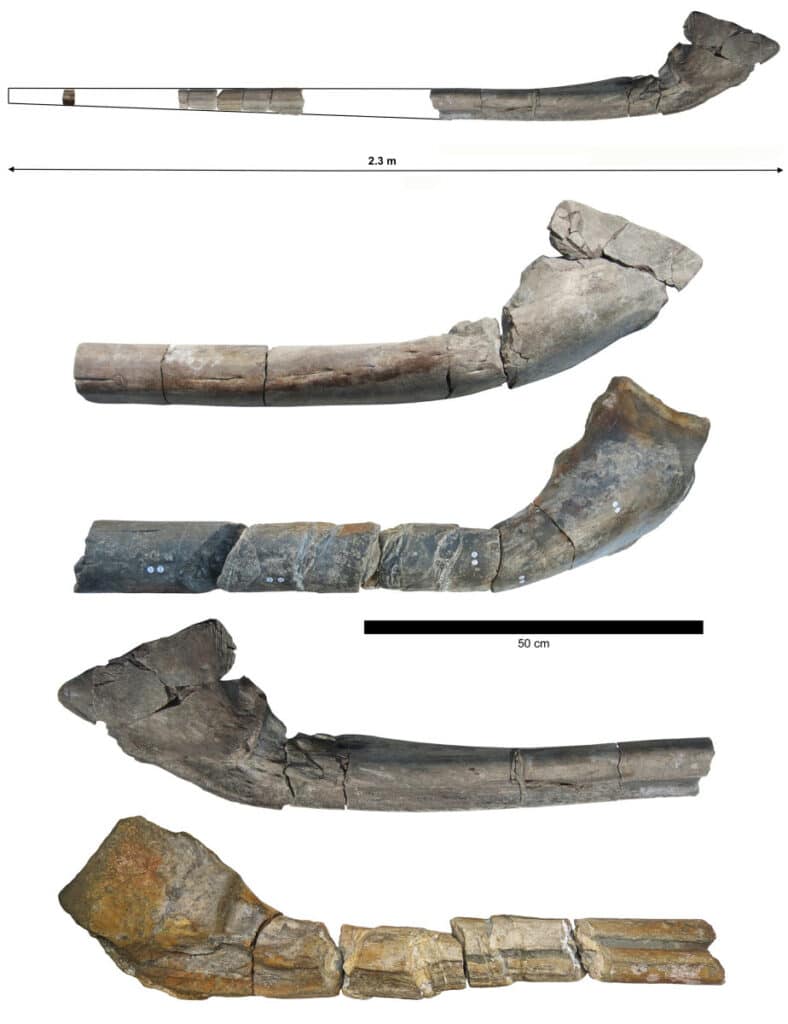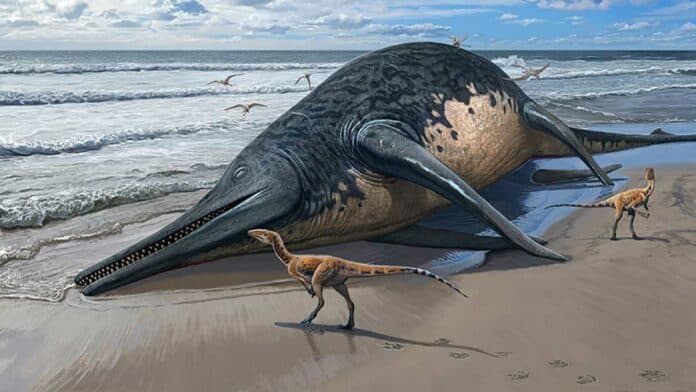Giant ichthyosaurs with body length estimates exceeding 20 m were present in the latest Triassic of the UK. A new study reports the discovery of a second surangular from the lower jaw of a giant ichthyosaur from Somerset, UK.
Father and daughter Justin and Ruby Reynolds from Braunton, Devon, were searching for fossils on the beach at Blue Anchor, Somerset, in May 2020. They found the first pieces of the second jawbone. Ruby, then aged 11, saw the first chunk of giant bone before searching together for additional pieces.
Sensing they had made a significant discovery, they contacted renowned ichthyosaur expert and University of Manchester paleontologist Dr. Dean Lomax.
Dr Dean Lomax said, “I was amazed by the find. In 2018, my team (including Paul de la Salle) studied and described Paul’s giant jawbone, and we had hoped that one day another would come to light. This new specimen is more complete and better preserved, and it shows that we now have two of these giant bones—called surangular bones—that have a unique shape and structure. I became very excited, to say the least.”
The team revisited the site, hoping to discover more pieces of this rare discovery. Over time, they found more fragments of the same jaw, which fit together like puzzle pieces assembled for millions of years.
The last piece of bone was recovered in October 2022. After detailed examination, scientists found that the jaw bones belonged to a previously undiscovered large ichthyosaur species, roughly equivalent in size to a blue whale. The two specimens of the same bone from the same geologic time zone can be identified by comparing their shared distinctive traits.
The team named this new genus and species Ichthyotitan severnensis, meaning “giant fish lizard of the Severn.”
The bones date to the end of the Triassic Period, during the Rhaetian Period, approximately 202 million years ago. The dinosaurs walked on land during this period, while the enormous ichthyosaurs swam the oceans. But it was the last chapter in the history of the Titans, for the fossils above tell the tale of a calamity known as the Late Triassic global mass extinction event. Giant ichthyosaurs belonging to the Shastasauridae family become extinct after this point. These bones are the very last of their sort that exist today.
Dr Lomax added: “I was highly impressed that Ruby and Justin correctly identified the discovery as another enormous jawbone from an ichthyosaur. They recognized that it matched the one we described in 2018. I asked them whether they would like to join my team to study and describe this fossil, including naming it. They jumped at the chance. For Ruby, especially, she is now a published scientist who not only found but also helped to name a type of gigantic prehistoric reptile. There are probably not many 15-year-olds who can say that! A Mary Anning in the making, perhaps.”
Ruby remarked: “Finding a piece of this massive ichthyosaur was fascinating. Being a part of such an important scientific discovery makes me very proud.”
Germany’s University of Bonn master’s student Marcello Perillo has conducted more analysis of the internal structures of the bones. His research verified that the bones belonged to an ichthyosaur and showed that the animal was still growing when it died.

He said: “We could confirm the unique set of histological characters typical of giant ichthyosaur lower jaws: the anomalous periosteal growth of these bones hints at yet-to-be-understood bone developmental strategies, now lost in the deep time, that likely allowed late Triassic ichthyosaurs to reach the known biological limits of vertebrates in terms of size. So much about these giants is still shrouded by mystery, but one fossil at a time, we can unravel their secret.”
Concluding the work, Paul de la Salle added: “To think that my discovery in 2016 would spark so much interest in these enormous creatures fills me with joy. When I found the first jawbone, I knew it was something special. Having a second to confirm our findings is incredible. I am overjoyed.”
The new research has been published today in the open-access journal PLOS ONE.
Ruby, Justin, and Paul’s discoveries will soon be displayed at the Bristol Museum and Art Gallery.
Lomax said: “This research has been ongoing for almost eight years. It is remarkable to think that gigantic, blue whale-sized ichthyosaurs were swimming in the oceans around the UK during the Triassic Period. These jawbones provide compelling evidence that perhaps one day a complete skull or skeleton of one of these giants might be found. You never know.”
Journal Reference:
- Dean R. Lomax, Paul de la Salle, Marcello Perillo, Justin Reynolds, Ruby Reynolds, James F. Waldron. The last giants: New evidence for giant Late Triassic (Rhaetian) ichthyosaurs from the UK. PLOS ONE, 2024; 19 (4): e0300289 DOI: 10.1371/journal.pone.0300289
